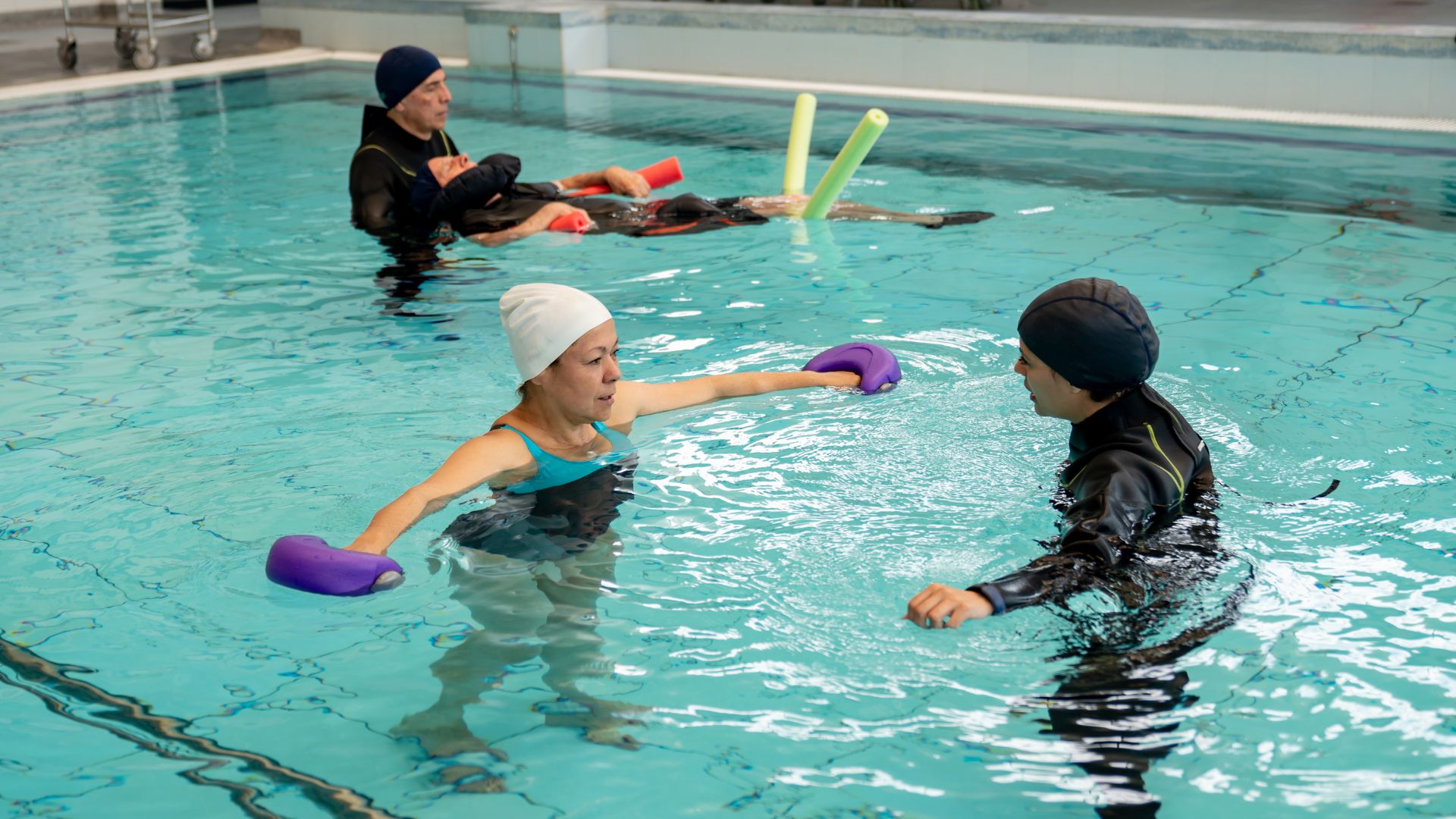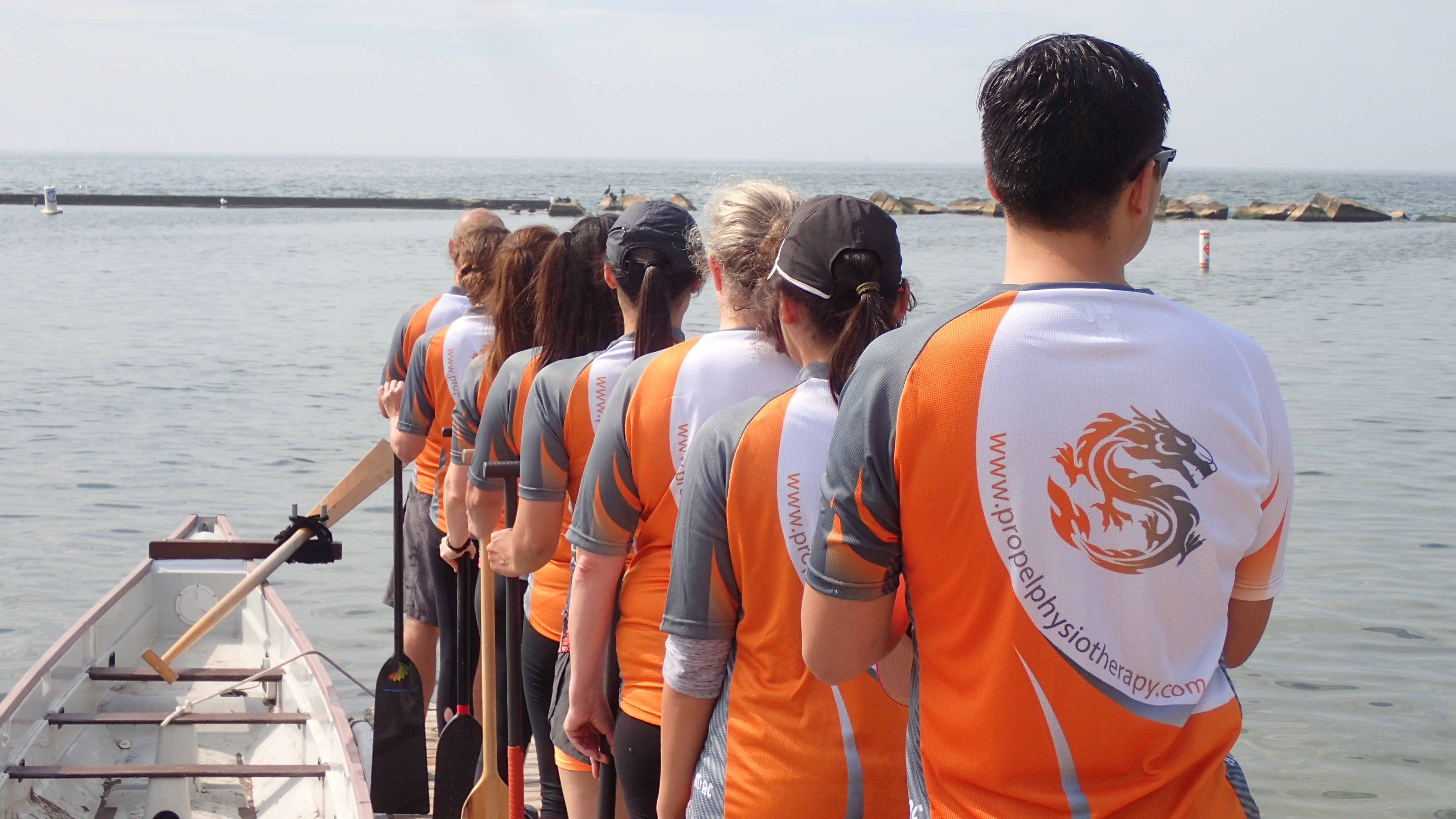Offering a sanctuary from the constraints of gravity, hydrotherapy provides a conducive environment for exercise and movement, facilitating recovery and enhancing overall quality of life. At Propel Physiotherapy, we use hydrotherapy in conjunction with land-based therapy to deliver holistic care to our clients.
In this article, we discuss the various benefits of hydrotherapy for rehabilitation and how it can be utilized with a wide variety of clients and populations. We also talk about the importance of setting goals, monitoring progress and tips for getting started.
Table of Contents
- What is hydrotherapy?
- The benefits of hydrotherapy for rehabilitation
- Who should use hydrotherapy for rehabilitation?
- Types of hydrotherapy exercises and activities
- Safety measures for hydrotherapy sessions
- Setting goals and monitoring progress for hydrotherapy
- Tips for getting started with hydrotherapy
- Conclusion
What is Hydrotherapy?
Hydrotherapy, also known as aquatic therapy, water therapy or pool therapy, involves the therapeutic use of water to treat various conditions or promote overall health and well-being. It encompasses a range of techniques and exercises performed in water, often in heated pools, to achieve physical, mental, or emotional benefits.
The Benefits of Hydrotherapy for Rehabilitation
There are distinct advantages to hydrotherapy over land-based therapy, offering a unique avenue for rehabilitation. With reduced impact on joints, increased buoyancy promoting mobility, and resistance provided by water, hydrotherapy opens up new possibilities for many people. There are three main benefits of hydrotherapy I see my patients experience first hand.
One notable advantage is the freedom water grants them to achieve more. Patients striving to regain their ability to walk often rely on aids like walkers and canes during clinic sessions. However, in the water, these aids become unnecessary. The buoyancy of water becomes their ally, enabling them to engage in exercises otherwise unattainable on land. From sets of lunges and squats for those dependent on walkers to gentle jogging for those transitioning away from canes, water-based activities not only build muscle strength but also enhance walking abilities and diminish reliance on aids.
Furthermore, the aquatic environment facilitates a range of unique movements. With equipment feeling lighter in water, exercises become more accessible for certain patients. Despite maintaining familiar push-and-pull motions, the resistance provided by water creates a nuanced workout experience. Small adjustments in equipment movement lead to subtle increases and decreases in resistance, resulting in an efficient, low-impact workout that leaves patients feeling accomplished and invigorated.
Lastly, I’ve witnessed profound relief in my patients when immersed in water. The alleviation of body weight on injured limbs provides immediate comfort, sparing them the burden of heavy pressure on their joints. Throughout the session, the absence of this weight allows for greater freedom of movement and enhanced flexibility, fostering a sense of relief and motivation to persist in their therapy journey.
Who Should Use Hydrotherapy for Rehabilitation?
Patients referred to me for pool sessions are often recommended by their doctor or primary physiotherapist. These individuals typically possess limited mobility on land, necessitate muscle-building exercises inaccessible on land, or endure pain that demands extremely low-impact movement.
Interestingly, a patient’s mobility level or their reliance on aids rarely poses a hindrance to their participation. In my experience, I’ve collaborated with individuals requiring 24/7 oxygen support, those with cognitive developmental delays, and various other physical conditions, all of whom have benefited from hydrotherapy.
However, a significant barrier preventing some individuals from accessing hydrotherapy is the risk of infections or a compromised immune system. While not all pools present this concern, private clinical pools designed exclusively for therapeutic use offer a safe haven for such patients, albeit with limited availability.
For those contemplating hydrotherapy, a useful checklist includes assessing whether land-based exercises cause pain, whether aids are consistently necessary for walking or standing, and whether low-impact exercises are required to kickstart their rehabilitation journey. These considerations help individuals determine if hydrotherapy aligns with their needs and goals.
Types of Hydrotherapy Exercises and Activities
At the onset of each pool session, a warm-up routine is standard practice. Similar to land-based sessions, warming up is crucial in the aquatic setting, especially considering the potential shock of cold water for some individuals. The slightly cooler temperature of the water serves a purpose: as you gradually warm up, the water begins to feel more comfortable. Adjusting the water temperature to a warmer level initially might seem ideal, but it could lead to discomfort once exercise begins due to increased body heat during swimming or other activities.
The exercises undertaken during a pool session are entirely tailored to the individual patient’s needs and objectives. For those focusing on specific muscle groups like hamstrings to enhance walking abilities, basic movements such as high knees, heel kicks, lunges, and squats are incorporated, often impossible to perform with the same ease on land.
The buoyancy of water significantly reduces body weight, making balancing exercises more manageable. Activities like hopping backward or swinging a leg forward and back are achievable only in water, with the depth gradually adjusted from deep to shallow as patients progress, requiring greater self-support.
Utilizing equipment enhances the effectiveness of water-based exercises. Pool noodles offer support during stretches or serve as “weights” for arm exercises, while specialized water weights provide additional resistance for arm workouts. Even a simple pool ball can become a valuable tool for underwater transfers during arm or abdominal exercises.
Swimming strokes emerge as a highly beneficial cardiovascular exercise, particularly for patients with advanced swimming abilities. Incorporating swimming laps helps maintain a raised heart rate between stationary exercises, contributing to overall fitness and endurance.
For patients with limited arm mobility, mastering swimming strokes like breaststroke with assistance from the opposite arm fosters gradual improvement. Similarly, individuals working on jogging in water experience the supportive benefits of aquatic exercise, aiding in cardio conditioning despite limitations on land-based jogging.
In essence, many exercises retain the same fundamental movements as their land-based counterparts, yet the unique properties of water, including resistance and buoyancy, distinguish aquatic workouts, offering a refreshing and effective alternative to traditional rehabilitation methods.
Safety Measures for Hydrotherapy Sessions
Within the pool environment, a robust framework of safety measures ensures the well-being of all participants. Lifeguards vigilantly monitor the pool, enforcing rules to uphold patron safety, while maintenance teams diligently maintain the pool systems to ensure operational integrity.
When conducting one-on-one sessions with a patient, prioritizing safety from the outset is paramount. Prior to the session, I ascertain the patient’s swimming proficiency and familiarize them with the pool layout and facilities. Together, we determine the most suitable entry and exit points, whether via ladders, stairs, or a chair lift, with the lifeguard team available to assist with any necessary transfers.
We commence sessions in the shallow end, providing patients with an opportunity to acclimate to the water and gauge their balance and weight distribution. Progression to deeper waters is contingent upon the patient’s comfort level and my assessment of their readiness.
While deep water offers advantages for certain exercises and enables the utilization of the full pool length, sessions can be effectively conducted in shallow water as well. Regardless of depth, safety remains paramount, necessitating adherence to boundaries and attentive cooperation with pool staff directives.
In hydrotherapy, fostering a sense of security and confidence is essential to ensuring a positive and productive experience for all participants. By prioritizing safety measures and maintaining open communication, we create a supportive environment conducive to therapeutic progress and well-being.
Setting Goals and Monitoring Progress for Hydrotherapy
Monitoring progress in the pool involves setting and achieving specific goals, typically focused on completing prescribed sets or distances. Initially, we establish realistic objectives for each exercise, such as completing three sets of ten repetitions, holding a position for thirty seconds, or traversing a distance of twenty-five meters.
Once a patient consistently achieves these goals in three separate instances, it indicates readiness to progress to new challenges. Hydrotherapy progression isn’t solely about increasing resistance; it’s about refining movements. For instance, a patient proficient in an exercise while using the pool wall for support may transition to facing the wall with one hand, thereby enhancing balance and stability.
As patients advance, we adjust the water depth, transitioning from deeper to shallower waters to progressively incorporate more of their body weight, thereby intensifying the workout. Throughout this process, we continuously monitor goal completion to ensure steady progress.
While certain exercises have limitations in terms of progression, we adapt by introducing new movements targeting the same muscle groups. This ensures ongoing engagement and effective challenge for the patient.
Many clients report feeling relaxed and invigorated after pool sessions, attributing this to targeted muscle stretching and activation. Witnessing their progress firsthand is immensely rewarding, such as observing one gentleman I work with gradually reducing his reliance on aids and improving balance and strength over time.
Collaboration with physiotherapists and registered massage therapists is integral to holistic patient care. Success in hydrotherapy often translates to enhanced performance in clinic-based sessions and improved functionality on land, underscoring the efficacy of this integrated approach. These milestones are a testament to the dedication and progress of our patients, reaffirming the transformative benefits of hydrotherapy in rehabilitation.
Tips for Getting Started with Hydrotherapy
If you’re contemplating hydrotherapy, I recommend you explore your local pool and engage with the lifeguards and instructors there. Assess how the environment resonates with you and observe the activities of other patrons during the times you plan to visit. It’s a common sight in many pools to witness individuals engaging in rehabilitation in the water.
If possible, try out simple movements like walking back and forth and gauge how your body responds. Ask yourself: “Does this feel easier on my body?” “Am I able to do more here?” “Do I experience relief in the water?” These reflections can provide valuable insights into the potential benefits of hydrotherapy for you.
While hydrotherapy may not suit everyone, with proper guidance, it can offer a rewarding journey of self-discovery and understanding of your body’s capabilities. To maximize the benefits of hydrotherapy, be prepared for an active session.
Take breaks as needed, but recognize that the buoyancy of water often enables patients to achieve more, making efficient use of your time is essential. Additionally, be mindful of the water’s temperature; remaining stationary in cold water can lead to discomfort.
If you encounter any hesitations or discomfort with specific exercises or movements in the water, communicate openly with your therapist. As a hydrotherapist, I always have alternative exercises readily available to help achieve our shared goals comfortably. Your feedback is invaluable, as you know your body best, and together, we can tailor the hydrotherapy experience to best suit your needs and preferences.
Conclusion
In conclusion, hydrotherapy offers a dynamic and effective approach to rehabilitation, harnessing the therapeutic properties of water to promote healing and enhance overall well-being. Through careful monitoring of progress and tailored exercise regimens, patients can experience tangible improvements in mobility, strength, and functionality.
Hydrotherapy is often used as a complementary treatment alongside other therapies or medical interventions. It’s important to consult with a healthcare professional before starting any hydrotherapy regimen, especially if you have existing health conditions or concerns.
While hydrotherapy may not be suitable for everyone, with the right guidance and support, it can serve as a valuable tool in understanding and nurturing the body’s capacity for recovery and growth. Embracing an active approach to sessions, while remaining mindful of individual needs and comfort, can maximize the benefits derived from hydrotherapy.
At Propel Physiotherapy, our therapists have extensive experience using hydrotherapy in many neurological and orthopaedic conditions. Our team will help create a tailored and individualized therapeutic approach to help you get the most benefit from your hydrotherapy program.
Contact us today to see how hydrotherapy can benefit you!
Written by













